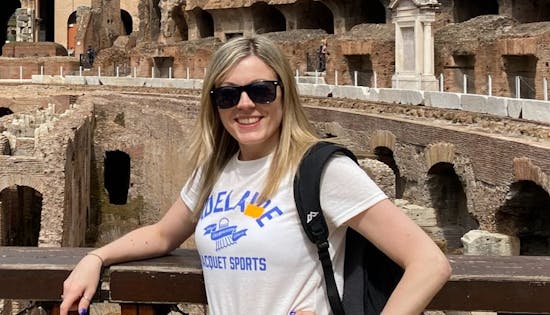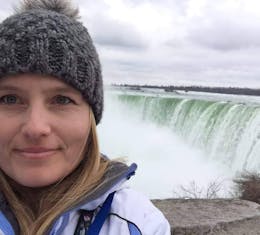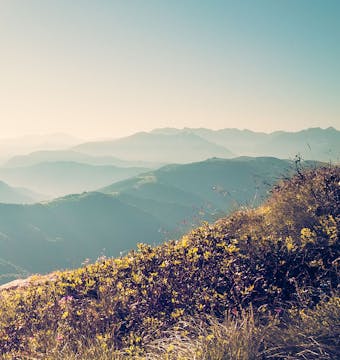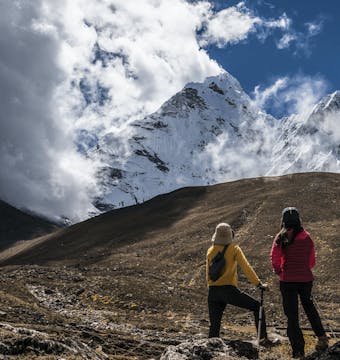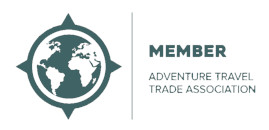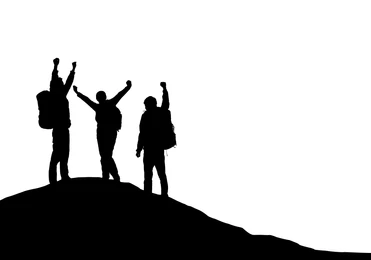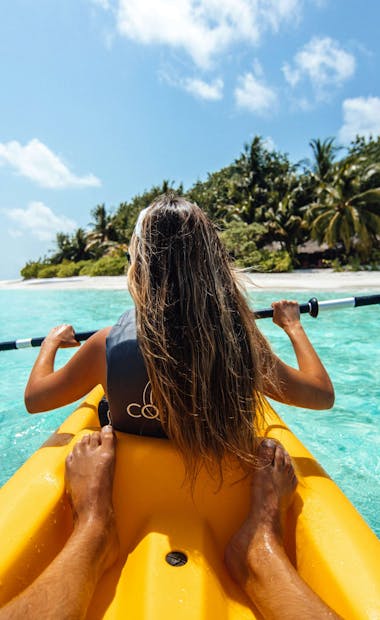Annapurna Treks
Trek through the majestic heights of the Annapurna Range, through canyons, forests and remote villages
Popular tours
- Save25%
 View Tour
View TourAnnapurna Sanctuary - 15 Days
- Kathmandu to Kathmandu
- Age group: 12 - 100
- Max group size: 15
Was:£879From£656 - Save7%
 View Tour
View TourAnnapurna Circuit - 15 Days
- Kathmandu to Kathmandu
- Age group: 14 - 80
- Max group size: 16
Was:£1,475From£1,372 - Save16%
 View Tour
View TourAnnapurna Foothills - 9 Days
- Kathmandu to Pokhara
- Age group: 15 - 99
- Max group size: 12
Was:£635From£534 - Save15%
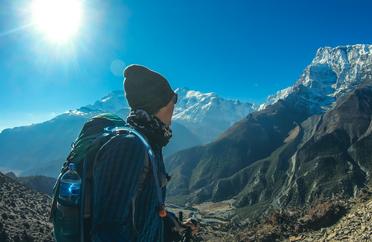 View Tour
View TourAnnapurna Base Camp - 14 Days
- Kathmandu to Kathmandu
- Age group: 15 - 99
- Max group size: 16
Was:£1,173From£997 - Save11%
 View Tour
View TourAnnapurna Circuit Trek - 15 Days
- Kathmandu to Pokhara
- Age group: 15 - 99
- Max group size: 12
Was:£1,085From£967 - Save25%
 View Tour
View TourAnnapurna Circuit Trek - 18 Days
- Kathmandu to Kathmandu
- Age group: 12 - 100
- Max group size: 15
Was:£1,299From£969
Annapurna Treks
Welcome to the world of Annapurna, a trekker's paradise nestled in the heart of the majestic Himalayas. Embark on a journey that will take you through breath-taking landscapes, charming villages, and awe-inspiring mountain vistas. Our small guided trekking tours offer an unforgettable experience, combining adventure, cultural immersion, and natural beauty. Get ready to discover the wonders of the Annapurna region and create memories that will last a lifetime.
Why Choose Annapurna Treks?
Spectacular Mountain Views: The Annapurna region is renowned for its panoramic views of towering peaks, including Annapurna I, Machapuchare, and Dhaulagiri. Capture awe-inspiring sunrises and sunsets over snow-capped mountains that will leave you breathless.
Diverse Landscapes: Trek through diverse landscapes, from lush forests and terraced fields to barren high-altitude deserts. Experience the ever-changing scenery as you navigate through valleys, rhododendron forests, and glacial moraines.
Rich Cultural Encounters: Immerse yourself in the vibrant local culture of the Annapurna region. Encounter traditional villages, interact with friendly locals, and witness their unique way of life. Explore ancient monasteries, prayer flags, and sacred sites that reflect the deep-rooted spiritual traditions of the Himalayan people.
Varied Trekking Routes: Choose from a range of trekking routes to suit your preferences and fitness level. Whether you opt for the classic Annapurna Circuit, the shorter Annapurna Base Camp trek, or other off-the-beaten-path routes, there is a trek for everyone.
Professional Guides and Support: Our experienced guides are passionate about the Annapurna region and will ensure your safety, comfort, and enjoyment throughout the trek. They have extensive knowledge of the trails, local customs, and the best viewpoints, making your trek a truly enriching experience.
Teahouse Accommodation: Experience the charm of traditional teahouse lodges along the trekking routes. These cozy accommodations provide comfortable lodging and local hospitality, allowing you to rest and recharge after a day of trekking.
Delicious Local Cuisine: Indulge in hearty Nepali and Tibetan cuisine during your trek. Savor delicious dal bhat (rice and lentil soup), momos (dumplings), and other local delicacies prepared with fresh, locally sourced ingredients. Vegetarian and dietary options are also readily available.
Responsible Tourism: We are committed to promoting responsible and sustainable tourism practices. We respect the local culture, support local communities, and strive to preserve the natural environment for future generations.
The best time to trek Annapurna is during the spring (March to May) and autumn (September to November) seasons. These months offer stable weather, clear skies, and moderate temperatures, providing optimal conditions for trekking. However, with proper gear and preparation, Annapurna can be trekked year-round.
Join us on an Annapurna trek and let the Himalayas work their magic on you. Explore the natural wonders, connect with local communities, and challenge yourself amidst the awe-inspiring landscapes. Contact us to start planning your unforgettable Annapurna adventure today.
When is the best time to trek Annapurna?
The best time to trek Annapurna is during the spring (March to May) and autumn (September to November) seasons. These months offer the most favorable weather conditions and stunning views of the Himalayas. Here's a breakdown of the seasons and their characteristics:
Spring (March to May): This is the peak trekking season in Annapurna. The weather is generally mild, with clear skies and moderate temperatures. The lush vegetation comes to life, and colorful rhododendron blooms adorn the hillsides, creating a picturesque landscape. It's an excellent time for photography enthusiasts and nature lovers.
Autumn (September to November): Another popular season for Annapurna treks, autumn brings stable weather and post-monsoon clear skies. The temperatures are pleasant during the day, and the views of the mountains are spectacular. The trails are usually less crowded compared to the spring season, offering a more serene trekking experience.
While spring and autumn are the preferred seasons, Annapurna can be trekked year-round with proper gear and preparation. Here's a brief overview of the other seasons:
Summer/Monsoon (June to August): This season sees heavy rainfall, particularly in July and August. The trails can be muddy and slippery, and there is a higher risk of landslides. However, the countryside is lush and green, and the valleys are less crowded. Trekking during this season requires good rain gear and caution.
Winter (December to February): Winter brings colder temperatures, especially at higher altitudes. The days are shorter, and there may be occasional snowfall. Trekking during this season requires warm clothing, proper gear, and an understanding of the challenges of trekking in cold conditions. However, the trails are relatively quieter, and you can enjoy the serene beauty of the snow-covered landscapes.
It's important to note that weather conditions can vary, and it's always advisable to check the current weather forecast and consult with local trekking agencies for the most up-to-date information. Regardless of the season you choose, Annapurna's natural beauty and trekking opportunities are sure to leave you awe-inspired.
Is Annapurna a demanding trek?
Trekking in the Annapurna region can vary in difficulty depending on the specific route and itinerary chosen. While some treks in the Annapurna region are challenging and require a high level of fitness, there are also options available for trekkers of varying experience and fitness levels. Here are a few factors to consider when evaluating the difficulty of Annapurna treks:Duration and Distance: The duration of Annapurna treks can range from a few days to several weeks, depending on the chosen route. Longer treks naturally require more endurance and stamina. The distances covered each day can also vary, with some days involving longer hours of walking and more challenging terrain.
Altitude: Altitude is a significant consideration when trekking in the Annapurna region. Some treks reach high elevations, including the popular Annapurna Circuit and Annapurna Base Camp treks. Acclimatization is crucial to minimize the risk of altitude sickness. Proper pacing and allowing time for rest and acclimatization are important for a safe and enjoyable trek.
Terrain and Trail Conditions: The Annapurna region offers diverse landscapes, including forested trails, rocky terrains, steep ascents, and descents. Some sections may involve challenging climbs or narrow and uneven paths. Trekkers should be prepared for a variety of trail conditions and terrain challenges, including crossing suspension bridges and navigating through rugged terrain.
Weather Conditions: Weather conditions in the Annapurna region can vary, and trekkers should be prepared for changing weather patterns. It's essential to pack suitable clothing for both warm and cold conditions, as temperatures can fluctuate during the trek. Additionally, treks during the monsoon season (June to August) may experience heavy rainfall, making the trails more challenging.
It's recommended that trekkers have a reasonable level of physical fitness and undertake some preparation before embarking on an Annapurna trek. Regular exercise, including cardiovascular workouts and strength training, can help build endurance and prepare the body for the physical demands of trekking. Additionally, previous trekking experience can be beneficial but is not always necessary, especially for shorter and less strenuous treks.
It's important to assess your own fitness level and choose a trek that matches your capabilities and interests. Consulting with a reputable trekking agency or tour operator can help you select a suitable trekking route and provide guidance on the level of difficulty. Remember to trek at your own pace, listen to your body, and prioritize your safety throughout the journey.
How fit do I need to be to trek Annapurna?
To trek in the Annapurna region, it is recommended to have a moderate to good level of fitness. While the exact fitness requirements can vary depending on the specific trek and route chosen, having a reasonable level of physical fitness will enhance your trekking experience and help you cope with the challenges along the way. Here are some key fitness considerations for trekking Annapurna:
Cardiovascular Fitness: Trekking in the Annapurna region involves walking for several hours each day, sometimes on steep ascents and descents. Building cardiovascular endurance through activities such as jogging, hiking, cycling, or using a treadmill can help prepare your body for the sustained physical exertion of trekking.
Strength and Endurance: Strengthening your leg muscles, core, and upper body can be beneficial for tackling the varied terrain and carrying a backpack. Incorporate exercises like squats, lunges, step-ups, planks, and push-ups into your fitness routine to improve your strength and endurance.
Flexibility: Maintaining good flexibility will help prevent muscle strains and injuries. Stretching exercises and activities like yoga or Pilates can improve your flexibility, making it easier to navigate the uneven and challenging terrain.
Mental Preparedness: Trekking in the mountains requires mental resilience and determination. Prepare yourself mentally for long days of walking, potential altitude-related challenges, and adapting to different weather conditions. A positive mindset and a willingness to push yourself outside your comfort zone can greatly enhance your trekking experience.
It's important to start preparing well in advance of your trek. Give yourself sufficient time to gradually build up your fitness level through regular exercise. Begin with shorter hikes or walks and gradually increase the duration and intensity as your fitness improves.
Remember that trekking in the Annapurna region can be physically demanding, but there are also various trekking options available to suit different fitness levels. If you have any concerns about your fitness or health, consult with a healthcare professional before undertaking the trek. It's always better to be well-prepared and aware of your capabilities to ensure a safe and enjoyable trekking experience.
Is altitude sickness a risk when trekking Annapurna?
Altitude sickness, also known as acute mountain sickness (AMS), is a potential risk when trekking in the Annapurna region or any other high-altitude trek. The Annapurna region offers a wide range of trekking routes with varying altitudes, and the risk of altitude sickness can depend on the specific route and the altitude gained during the trek. It's important to be aware of the risks and take necessary precautions to prevent altitude sickness. Here are some key points to consider:
Gradual Acclimatization: One of the best ways to prevent altitude sickness is to acclimatize gradually. This involves ascending at a slow pace, allowing your body time to adjust to the increasing altitude. It's recommended to follow the principle of "climb high, sleep low," which means ascending to higher altitudes during the day and descending to lower altitudes to sleep.
Hydration: Proper hydration is crucial at high altitudes. Drink plenty of fluids, preferably water, to stay hydrated and compensate for the increased water loss due to higher altitudes and physical exertion. Avoid excessive consumption of alcohol and caffeinated beverages as they can contribute to dehydration.
Recognize Symptoms: It's essential to recognize the symptoms of altitude sickness, which can include headache, nausea, dizziness, fatigue, loss of appetite, and difficulty sleeping. If you experience any of these symptoms, it's important to take them seriously and communicate with your trekking guide or fellow trekkers.
Acclimatization Days: Many Annapurna trekking itineraries include acclimatization days, which provide an opportunity to rest and allow your body to adjust to the altitude. Use these days wisely and avoid strenuous activities. Take short walks to higher elevations and return to a lower altitude to sleep.
Medication: In some cases, trekking at high altitudes may require medication to prevent or treat altitude sickness. Consult with a healthcare professional before your trek to discuss the possibility of taking medication such as acetazolamide (Diamox) and its suitability for you.
Listen to your Body: It's important to listen to your body and communicate any concerns or symptoms with your trekking guide. They are experienced in dealing with altitude-related issues and can provide appropriate guidance.
Remember that everyone's body reacts differently to altitude, and there is no way to predict how an individual will acclimatize. It's essential to be prepared, take the necessary precautions, and be aware of your own limits. Choosing a reputable trekking agency that prioritizes safety and employs experienced guides can also contribute to a safer and more enjoyable trekking experience.
What is the accommodation on the Annapurna trek?
Accommodation during the Annapurna trek varies depending on the specific route and the level of comfort you prefer. The Annapurna region offers a range of options, from basic teahouses to more luxurious lodges. Here are the common types of accommodation you can expect during the Annapurna trek:Teahouses/Guesthouses: Teahouses are the most common type of accommodation along the Annapurna trekking routes. These are basic lodges that provide rooms with essential amenities such as beds, blankets, and sometimes hot showers (though hot water availability can vary). Teahouses usually have communal dining areas where you can enjoy meals and socialize with other trekkers. Keep in mind that the facilities in teahouses may be basic, and you may need to share a room with other trekkers depending on availability.
Lodges: As you trek through more popular sections of the Annapurna circuit, you may find lodges that offer slightly more comfort and amenities compared to teahouses. Lodges may have private rooms with attached bathrooms and hot water showers. They often have a cozy dining area and common spaces where you can relax and unwind.
Camping: If you prefer a more adventurous experience or if you are trekking on less-traveled routes, camping is an option. Camping involves setting up tents and carrying your own camping gear or hiring a trekking agency that provides camping equipment and support staff. Camping allows for a more immersive experience in nature but requires additional logistical arrangements.
It's important to note that accommodation options can vary along different sections of the Annapurna trek, and the level of comfort may differ depending on the altitude and remoteness of the area. During peak trekking seasons, teahouses and lodges can get crowded, so it's advisable to book in advance or with the help of a trekking agency to secure accommodation along the route.
Regardless of the type of accommodation, it's important to have realistic expectations as facilities in the mountains may be more basic compared to urban areas. It's part of the trekking experience to embrace simplicity, enjoy the natural surroundings, and connect with fellow trekkers.
What should I pack for my Annapurna trek?
Packing appropriately for your Annapurna trek is essential to ensure your comfort and safety throughout the journey. Here's a list of essential items you should consider packing:Trekking Gear:
- Sturdy and comfortable hiking boots
- Trekking poles for stability and support
- Lightweight and quick-drying trekking pants
- Moisture-wicking base layers and thermal tops
- Insulated jacket or fleece for warmth
- Waterproof and windproof outer shell jacket and pants
- Warm hat, gloves, and buff/scarf
- Sunglasses and sun hat for sun protection
- Daypack to carry your essentials during the trek
Sleeping Gear:
- Sleeping bag suitable for cold temperatures (rated for at least -10 degrees Celsius)
- Sleeping pad or mat for insulation and comfort
Clothing:
- Moisture-wicking and breathable T-shirts
- Lightweight, long-sleeved shirts for sun protection
- Underwear and comfortable hiking socks (wool or synthetic)
- Swimwear (for hot springs or showers, if available along the trek)
Personal Hygiene and Toiletries:
- Biodegradable soap and shampoo
- Toothbrush and toothpaste
- Hand sanitizer and wet wipes
- Quick-drying towel
- Sunscreen with high SPF
- Insect repellent
- Toilet paper and zip-lock bags for waste disposal
First Aid Kit:
- Prescription medications, if any
- Basic first aid supplies (band-aids, antiseptic cream, pain relievers, etc.)
- Blister treatment (moleskin or blister pads)
- Diamox or other altitude sickness medication (consult with a doctor)
Miscellaneous:
- Headlamp or flashlight with extra batteries
- Water bottle or hydration bladder
- Snacks and energy bars
- Cash (small denominations) for buying snacks, drinks, and souvenirs along the trek
- Trekking map and guidebook
- Camera or smartphone for capturing memories
- Power bank for charging electronic devices
- Waterproof bags or dry sacks to protect your gear from rain
Remember to pack light and prioritize essential items. It's also recommended to layer your clothing for versatility as temperatures can vary throughout the trek. Additionally, consider the specific season and weather conditions during your trek to adjust your packing list accordingly.
Is my luggage transported on the Annapurna treks?
Yes, on guided Annapurna treks, it is common for your main luggage to be transported for you. Most trekking agencies provide porters or mules to carry the bulk of your belongings, allowing you to trek with a lighter daypack that only carries your essentials for the day. This arrangement makes the trek more comfortable as you won't have to carry a heavy load on your back while hiking.It's important to note that there are weight limitations for the luggage that can be carried by porters or mules, usually around 10-15 kilograms (22-33 pounds). It's recommended to pack your belongings in a sturdy duffel bag or backpack that is suitable for transportation by porters. It's also a good idea to bring a small lock to secure your bag.
During the trek, you will have access to your main luggage in the evenings at the tea houses or lodges where you'll be staying. However, it's advisable to pack a separate small daypack or bag with essential items such as warm clothing layers, water, snacks, camera, sunscreen, and any other items you may need during the day's trek.
It's important to communicate with your trekking agency or tour operator to confirm the luggage arrangements and any specific guidelines they have regarding packing and weight limits.
What are the group sizes and mix on guided Annapurna treks?
Group sizes on guided Annapurna treks can vary depending on the trekking agency and the specific itinerary. However, typical group sizes range from small to medium-sized groups.
Small groups usually consist of around 4 to 8 trekkers, providing a more intimate and personalized experience. This allows for closer interaction with the guide and fellow trekkers, fostering a sense of camaraderie and shared adventure.
Medium-sized groups can have around 10 to 16 trekkers. While slightly larger, these groups still maintain a manageable size, allowing for individual attention from the guide and a sociable trekking experience.
The composition of the group can vary as well. Some trekking agencies may organize mixed-gender groups, while others may offer specific departures for women-only groups or solo travelers. It's worth checking with the trekking agency to inquire about the composition of the group and any specific options available.
Traveling with a group can enhance the trekking experience, as you'll have the opportunity to meet and connect with like-minded individuals from different backgrounds and cultures. Sharing the journey with fellow trekkers often creates a supportive and enjoyable atmosphere throughout the trek.
If you prefer a more private experience or have specific requirements, some trekking agencies also offer customized private treks for individuals, families, or small groups upon request.
Remember to communicate your preferences and requirements to the trekking agency when making your booking to ensure that the group size and composition align with your expectations.
What food can I expect when trekking Annapurna?
When trekking in the Annapurna region, you can expect a variety of delicious and nourishing meals to keep you energized throughout your journey. The food served on Annapurna treks combines local flavours with international cuisine, providing a diverse culinary experience. Here are some common foods you can expect:
Dal Bhat: Dal Bhat is a traditional Nepali dish and a staple of the local diet. It consists of steamed rice (bhat) served with lentil soup (dal), vegetables, pickles, and sometimes meat or curries. It's a wholesome and satisfying meal, providing a good balance of carbohydrates, protein, and nutrients.
Momos: Momos are popular dumplings that originated in Tibet but are widely enjoyed in Nepal. These steamed or fried dumplings are usually filled with vegetables or meat and served with a dipping sauce. Momos make for a tasty and comforting snack or meal option during the trek.
Thukpa: Thukpa is a hearty noodle soup with vegetables, meat (optional), and flavourful broth. It's a warm and comforting dish, perfect for colder days on the trek. Thukpa is a popular Tibetan dish and is commonly found along the Annapurna trekking routes.
Chapati/Roti: Chapati or roti is a type of unleavened bread made from wheat flour. It is often served with dal or curries and provides a good source of carbohydrates and energy.
Fresh Fruits and Vegetables: While trekking, you can enjoy a variety of fresh fruits and vegetables, including bananas, apples, oranges, cucumbers, tomatoes, and more. These provide essential vitamins and minerals to keep you healthy and hydrated.
Snacks and Tea: Along the trekking routes, you'll find teahouses and lodges where you can enjoy a variety of snacks such as potato fries, pakoras, samosas, and biscuits. Tea is a popular beverage, and you'll find a wide range of options, including masala tea, ginger tea, and lemon tea, which can provide warmth and comfort during breaks.
It's important to note that the food options may vary depending on the teahouse or lodge you stay in and the altitude of the trekking route. The teahouses typically prepare meals using fresh ingredients, and vegetarian options are readily available. Some teahouses also offer international dishes like pasta, pizza, and pancakes.
While trekking, it's recommended to maintain a balanced and nutritious diet, stay hydrated by drinking plenty of water, and avoid consuming uncooked or unhygienic food.
Can I access drinking water while on the Annapurna treks?
Yes, you can access drinking water during your Annapurna treks. Along the trekking routes, there are several options for obtaining safe drinking water:
Bottled Water: You can purchase bottled water at teahouses and lodges along the trekking trail. This is a convenient option, but keep in mind that plastic waste can be a concern in the mountains. Be sure to properly dispose of your empty bottles at designated collection points.
Boiled Water: Many teahouses offer boiled water that is safe for drinking. They use water from local sources and boil it to kill any harmful bacteria or parasites. You can ask the teahouse staff to provide you with boiled water, and they will charge a small fee for the service.
Water Purification Tablets or Filters: Another option is to carry water purification tablets or a water filtration system with you. This allows you to purify water from natural sources such as streams or taps, making it safe for consumption. Water purification tablets are lightweight and easy to use, while water filters can remove impurities and contaminants from the water.
It's important to note that while tap water from teahouses and lodges may be used for cooking and cleaning purposes, it's generally not safe for drinking without proper treatment. Therefore, it's advisable to rely on bottled water, boiled water, or treated water during your trek to ensure your hydration and well-being.
Staying hydrated is essential while trekking in the Annapurna region, as the altitude and physical exertion can lead to increased water loss through perspiration and respiration. Make sure to drink plenty of water throughout the day and maintain good hydration to support your overall health and acclimatization process.
Can I drink the tap water in Nepal?
In general, it is not recommended to drink tap water in Nepal, including in the Annapurna region. The tap water in Nepal may not be adequately treated and may contain harmful bacteria, parasites, or other contaminants that can cause waterborne illnesses.
To ensure your health and well-being, it is advisable to drink bottled water, boiled water, or purified water during your stay in Nepal. Bottled water is widely available in most hotels, teahouses, and shops in popular trekking areas like the Annapurna region. You can also ask for boiled water at teahouses and lodges, which is considered safe for drinking.
Alternatively, you can use water purification tablets or a water filtration system to treat water from natural sources like streams or taps. These methods help eliminate or reduce the risk of waterborne diseases by removing bacteria, viruses, and other impurities.
Remember to always check the seal of bottled water before purchasing, and ensure that any water you consume is properly treated and safe for drinking. It's important to prioritize your health and take necessary precautions to prevent water-related illnesses during your trek in the Annapurna region.
Is there Wifi on the Annapurna trekking routes?
The availability of Wi-Fi on the Annapurna trekking routes can vary depending on the specific location and the facilities along the trail. In general, the higher you ascend and the more remote the area, the less likely you are to find Wi-Fi access.In the lower regions of the Annapurna region, such as Pokhara or larger villages along the trek, you may find some guesthouses, teahouses, or lodges that offer Wi-Fi services. However, please note that the internet connection in these areas can be slow and unreliable due to limited infrastructure.
As you venture higher into the mountains and more remote sections of the Annapurna trek, it becomes less common to find Wi-Fi access. The focus of the trek is typically on enjoying the natural beauty and cultural experiences rather than relying on technology.
It's important to be prepared for limited or no Wi-Fi connectivity during your Annapurna trek. If staying connected is necessary, you may consider purchasing a local SIM card with data packages before starting the trek. However, keep in mind that signal strength can be weak or unavailable in some areas.
It's often recommended to embrace the opportunity to disconnect from the digital world and immerse yourself in the breath-taking surroundings and local culture along the Annapurna trek. Enjoy the experience of being in nature and interacting with fellow trekkers without the distractions of constant connectivity.
Is there a phone signal on the Annapurna trekking routes?
The availability of phone signal on the Annapurna trekking routes can vary depending on the specific location and the network coverage in the area. In general, you can expect to have some level of phone signal in the lower regions of the trek, such as Pokhara or larger villages along the route.As you ascend higher into the mountains and more remote sections of the Annapurna trek, the phone signal may become weaker or unavailable. The mountainous terrain and lack of infrastructure can impact the signal strength.
It's important to note that the primary purpose of trekking in the Annapurna region is to enjoy the natural beauty and cultural experiences. While there may be opportunities to get a phone signal at certain points along the trek, it's advisable to have realistic expectations and not rely heavily on phone communication.
If you need to stay connected for emergency purposes or important communication, it's recommended to check with your mobile service provider regarding their coverage in the area and consider purchasing a local SIM card with a network that has better coverage in the region.
Keep in mind that the Annapurna trek offers a chance to disconnect from technology and immerse yourself in the stunning mountain scenery and local culture. Embrace the opportunity to be present in the moment and enjoy the serenity of the trekking experience.
Is Annapurna a safe trek?
Trekking in the Annapurna region is generally considered safe, but like any outdoor adventure, there are inherent risks that should be taken into account. It's important to prioritize your safety and well-being by following some guidelines:
Trek with a Guide: It is highly recommended to trek with an experienced guide who is familiar with the route, local conditions, and can provide support and assistance throughout the journey. They can also help in case of emergencies and provide valuable insights into the culture and environment.
Stay Hydrated and Well-Nourished: Proper hydration and nutrition are crucial during the trek. Drink plenty of water, eat balanced meals, and carry some high-energy snacks to sustain your energy levels.
Acclimatize Properly: As you ascend to higher altitudes, it's essential to acclimatize properly to reduce the risk of altitude sickness. Take your time, follow a gradual ascent, and allow for rest days to allow your body to adjust to the altitude.
Dress Appropriately: The weather in the Annapurna region can be unpredictable, so it's important to pack and dress accordingly. Layered clothing, including a good-quality waterproof and windproof jacket, is recommended to adapt to changing weather conditions.
Follow Safety Guidelines: Pay attention to safety guidelines provided by your trekking agency, guides, and local authorities. Be aware of potential hazards along the trail, such as steep sections, unstable terrain, or river crossings, and exercise caution.
Maintain Communication: Inform someone about your trekking plans and expected itinerary. Carry a fully charged mobile phone or a satellite phone for emergency communication if needed.
Travel Insurance: It's essential to have comprehensive travel insurance that covers trekking activities, including emergency medical evacuation. Make sure to read and understand the policy coverage and keep a copy of your insurance details with you.
Respect Local Customs and Environment: Respect the local culture, customs, and traditions of the communities you encounter during the trek. Preserve the natural environment by following responsible trekking practices, such as carrying out your trash and avoiding single-use plastics.
By following these safety guidelines and being mindful of your personal well-being, you can have a safe and enjoyable trekking experience in the beautiful Annapurna region.
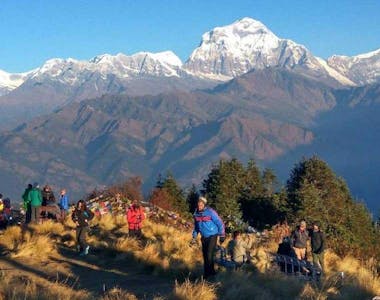
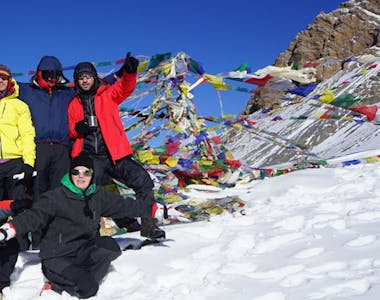
Annapurna Treks Highlights
Book With Confidence
Monthly Payments
Spread the costs with no interest or additional fees
Best Price Guarantee
We won't be beaten on price. If you find this adventure at a lower price please get in touch!
Reserve now & pay later
Reserve your adventure today and pay later, free of charge
ATOL protected
Book with confidence
Hold your space today, for free
or book your trip with a deposit and then pay the rest in instalments.
Reserve your flights with us
Add flights to your booking and we'll take care of the rest. You'll get 24/7 support from our team & ATOL protection.
Speak to our experts
Call or email our expert team to find out more and help with ideas and planning.
